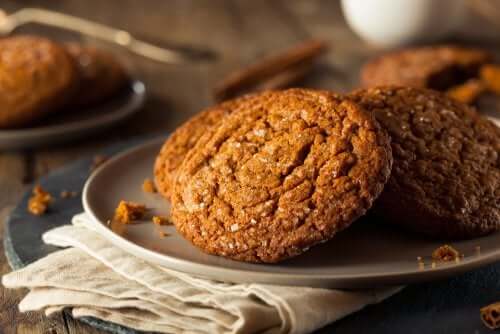Learn How to Make Gingerbread Cookies

Gingerbread cookies, very typical of the coldest countries, have become popular worldwide. Although people tend to make them during Christmas time, we decided to share this recipe with you so you can make them all year long!
However, firstly, it’s necessary to highlight certain general aspects of cookies.
Cookies are pastries, even if they don’t seem like it
People around the world eat cookies for breakfast and snacks. However, they’re made with the same ingredients as any pastry. Therefore, they’re nutritionally similar. All you have to do is read the labels and see the order in which they appear: refined or whole wheat flour, sugar or sweetener, refined olive, sunflower, or palm oil, milk serum, and other additives.
In addition, depending on the type of cookie, it can include eggs, chocolate and cream, among other ingredients. For this reason, they’re part of the group of pastries, and the only things they provide are sugar and trans fats.
Also, each brand uses its own strategies to attract its target audiences. For example, cookies for children are shaped like their favorite cartoon or animal to keep things fun and stimulate their imagination.

A curious fact is that these brands have taken advantage of the common practice of having carbohydrates for breakfast to promote their consumption. But if you take a good look, each country has different breakfast customs according to their culinary culture. Thus, there’s no one healthy breakfast.
Due to everything we mentioned above, cookies negatively impact health. Their regular consumption increases the risk of:
- Excess weight and obesity.
- Type 2 diabetes.
- Fatty liver.
- Cardiovascular diseases.
What if you make cookies at home?
In this case, the only thing you can change is the quality of the ingredients. How? Substituting white flour with whole wheat flour, reducing the amount of sugar, and using extra virgin olive oil. Another option regarding sugar is substituting it with fruit or dried fruit, such as dates, raisins or prunes, among others.
Gingerbread cookies
Ingredients
- 100 g of whole wheat flour.
- 30 g of corn starch.
- 100 g of ground almonds.
- 50 g of rice syrup.
- 1 tablespoon of ginger powder.
- A tablespoon of ground cinnamon.
- 1 teaspoon of leavening.
- 50 g of extra virgin olive oil.
- 1 pinch of salt.
- 75 ml of milk or vegetable drink without added sugar.
Preparation of the gingerbread cookies
Firstly, preheat the oven to 320°F. Then, mix the dry ingredients (the flour, corn starch, leavening, cinnamon, ginger, salt, and ground almonds) in a bowl. Add the olive oil and rice syrup. Then, add the milk or plant-based drink. Mix everything until all the ingredients are well-integrated and you get a manageable dough.
Roll the dough over a floured surface with the help of a rolling pin. Then, use a cookie cutter to give the cookies the shape you want. Ideally, you should opt for Christmas or winter elements. Put baking paper over a baking tray and then place the cookies on top. Bake for approximately 10 to 15 minutes or until golden brown. Finally, let cool.
Remember that you should only eat cookies sporadically because they may increase the risk of obesity and type 2 diabetes. Thus, make them every once in a while to celebrate a birthday or special occasion. Also, allow your children to help so they can learn and spend quality time with you.
Gingerbread cookies, very typical of the coldest countries, have become popular worldwide. Although people tend to make them during Christmas time, we decided to share this recipe with you so you can make them all year long!
However, firstly, it’s necessary to highlight certain general aspects of cookies.
Cookies are pastries, even if they don’t seem like it
People around the world eat cookies for breakfast and snacks. However, they’re made with the same ingredients as any pastry. Therefore, they’re nutritionally similar. All you have to do is read the labels and see the order in which they appear: refined or whole wheat flour, sugar or sweetener, refined olive, sunflower, or palm oil, milk serum, and other additives.
In addition, depending on the type of cookie, it can include eggs, chocolate and cream, among other ingredients. For this reason, they’re part of the group of pastries, and the only things they provide are sugar and trans fats.
Also, each brand uses its own strategies to attract its target audiences. For example, cookies for children are shaped like their favorite cartoon or animal to keep things fun and stimulate their imagination.

A curious fact is that these brands have taken advantage of the common practice of having carbohydrates for breakfast to promote their consumption. But if you take a good look, each country has different breakfast customs according to their culinary culture. Thus, there’s no one healthy breakfast.
Due to everything we mentioned above, cookies negatively impact health. Their regular consumption increases the risk of:
- Excess weight and obesity.
- Type 2 diabetes.
- Fatty liver.
- Cardiovascular diseases.
What if you make cookies at home?
In this case, the only thing you can change is the quality of the ingredients. How? Substituting white flour with whole wheat flour, reducing the amount of sugar, and using extra virgin olive oil. Another option regarding sugar is substituting it with fruit or dried fruit, such as dates, raisins or prunes, among others.
Gingerbread cookies
Ingredients
- 100 g of whole wheat flour.
- 30 g of corn starch.
- 100 g of ground almonds.
- 50 g of rice syrup.
- 1 tablespoon of ginger powder.
- A tablespoon of ground cinnamon.
- 1 teaspoon of leavening.
- 50 g of extra virgin olive oil.
- 1 pinch of salt.
- 75 ml of milk or vegetable drink without added sugar.
Preparation of the gingerbread cookies
Firstly, preheat the oven to 320°F. Then, mix the dry ingredients (the flour, corn starch, leavening, cinnamon, ginger, salt, and ground almonds) in a bowl. Add the olive oil and rice syrup. Then, add the milk or plant-based drink. Mix everything until all the ingredients are well-integrated and you get a manageable dough.
Roll the dough over a floured surface with the help of a rolling pin. Then, use a cookie cutter to give the cookies the shape you want. Ideally, you should opt for Christmas or winter elements. Put baking paper over a baking tray and then place the cookies on top. Bake for approximately 10 to 15 minutes or until golden brown. Finally, let cool.
Remember that you should only eat cookies sporadically because they may increase the risk of obesity and type 2 diabetes. Thus, make them every once in a while to celebrate a birthday or special occasion. Also, allow your children to help so they can learn and spend quality time with you.
All cited sources were thoroughly reviewed by our team to ensure their quality, reliability, currency, and validity. The bibliography of this article was considered reliable and of academic or scientific accuracy.
- Julio Basulto (2014). La galleta María es tan “bollería” como el croissant. Comer o no comer. [Actualizado el 25 de mayo de 2015, consultado el 31 de diciembre de 2019] Disponible en: https://comeronocomer.es/la-carta/la-galleta-maria-es-tan-bolleria-como-el-croissant
- Aitor Sánchez. (2018). Comprar bollería es como una hipoteca, te la vas a acabar comiendo y tú eliges los plazos.
- Raquel Márquez. (2016). La bollería, culpable de la obesidad infantil en aumento en España. El Confidencial.
- Informe de consumo alimentario en España 2018. Ministerio de agricultura, pesca y alimentación. Madrid, 2019.
- OMS. Nota informativa sobre la ingesta de azúcares recomendada en la directriz de la OMS par adultos y niños. Organización Mundial de la Salud, 2015.
- Te Morenga, L.; Mallard, S. y Mann, J. Dieatry sugar and body weight: systematic review and meta-analyses of randomised controlled trials and cohort studies. BMJ 2013, 346.
This text is provided for informational purposes only and does not replace consultation with a professional. If in doubt, consult your specialist.








